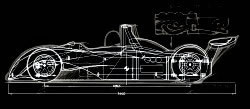Vortex
A vortex is a spinning flow of fluid. In particular, vortex is a spiral flow with closed streamlines. All vortices have some special properties. The air (or any fluid) pressure in a vortex is lowest in the center and rises progressively with distance from the center. This is in accordance with Bernoulli's Principle. Two or more vortices that are approximately parallel and circulating in the same direction will merge to form a single vortex. The circulation of the merged vortex will equal the sum of the circulations of the constituent vortices. For example, a sheet of small vortices flows from the trailing edge of the wing or propeller of an airplane when the wing is developing lift or the propeller is developing thrust will all merge to a single vortex. Vortices contain a lot of energy in the circular motion. In an ideal fluid this energy can never be dissipated and the vortex would persist forever. However, real fluids exhibit viscosity and this dissipates energy very slowly from the core of the vortex.
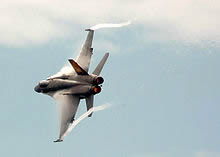 Wingtip vortices are circular patterns of rotating air left behind a wing as it generates lift. One wingtip vortex trails from the tip of each wing. Wingtip vortices are associated with induced drag, an unavoidable side-effect of three-dimensional lift or downforce generation. Wingtip vortex form because of the difference in pressure between the upper and lower surfaces of a wing that is operating at a positive or negative lift. Since pressure is a continuous function, the pressures must become equal at the wing tips. The tendency is for particles of air to move from the lower pressure surface around the wing tip to the higher pressure surface (from the region of high pressure to the region of low pressure) so that the pressure becomes equal above and below the wing. When the air leaves the trailing edge of the wing, the air from the upper surface is inclined to that from the lower surface, and helical paths, or vortices, result.
Wingtip vortices are circular patterns of rotating air left behind a wing as it generates lift. One wingtip vortex trails from the tip of each wing. Wingtip vortices are associated with induced drag, an unavoidable side-effect of three-dimensional lift or downforce generation. Wingtip vortex form because of the difference in pressure between the upper and lower surfaces of a wing that is operating at a positive or negative lift. Since pressure is a continuous function, the pressures must become equal at the wing tips. The tendency is for particles of air to move from the lower pressure surface around the wing tip to the higher pressure surface (from the region of high pressure to the region of low pressure) so that the pressure becomes equal above and below the wing. When the air leaves the trailing edge of the wing, the air from the upper surface is inclined to that from the lower surface, and helical paths, or vortices, result.
Aerodynamically speaking, a Formula 1 car is an interconnected system of vortices and vortex layers. The vorticity is created by viscous shear in thin boundary layers adjacent to the solid surfaces of the car. The downforce generated by a wing is often attributed to the presence of circulation in the airflow around the wing, but the circulation itself is nothing more than the net vorticity in the boundary layers above and below the wing.
When a vortex layer separates from a solid surface, it becomes a free vortex layer, and a separated vortex layer can roll-up into a volume of concentrated vorticity, called a vortex. Vortex have a low pressure core, in some sort of balance with the centrifugal force of the fluid elements spiralling around the vortex on helical trajectories. Oriented in a streamwise direction, such vortices can be particularly useful, both for the direct generation of downforce, and to act as air curtains, sealing off other low pressure areas, for example underbody low pressure area.
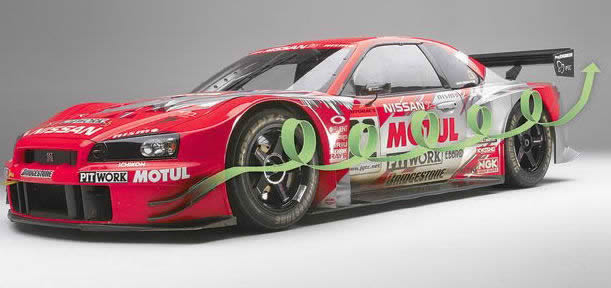 |
Canards, together with vortex generators, generate strong vortices that travel down the sides of the car and act as a barrier. If the canards are positioned correctly, these strong vortices act in way to keep high-pressure air around the car from entering the low-pressure underbody region, thus maintaining more downforce. |
Also, because of vortex high energy, we can use vortices (vortex generators) to prevent early flow separation from aerodynamicaly incorect body by energizing boundary layer. There are reported examples of aircraft wings controlling the boundary layer, in which vortex generators successfully delayed flow separation even when the critical Reynolds number is exceeded. Although the purpose of using vortex generators is to control flow separation.
Vortex generators themselves create drag, but they also reduce drag by preventing flow separation at downstream. The overall effect of vortex generators can be calculated by totaling the positive and negative effects, since this effect depends on the shape and size of vortex generators. To select appropriate shape and size of the vortex generator which generates streamwise vortex the most efficiently (with the least drag by itself) is important to achieve our objectives.
Now, the front-wing of a Formula 1 car sees the air first, and therefore sets the conditions for the rest of the car, hence the vortices it generates are particularly important. Front wing vortices are generated by lateral pressure gradients within the front wing assembly, and these exist across the endplate, at the transition between the wing section and the neutral inner-section dictated by regulation, at the inner tips of the front-wing flaps, and at the arched sections in the front-wing. Position and number of vortices is precisely calculated and positioned in realation with the rest of the bodywork downstream, and specialy with relation with open rotating wheels. Wrongly calculated and positioned vortex stream can distroy a months of work and milions of dollars.
In Formula 1 for example, bargeboards are used to guide turbulent air from the front wing wake, away from the vital airflow underneath the car. In addition, the lower trailing edge of a bargeboard creates a vortex which travels down the outer lower edge of the sidepod, acting as a skirt or dam, helping to seal the lower pressure area under the car. With such techniques we can see continued utility of ground effect in Formula 1.
This article is reproduced from Mulsanne's Corner website, website about Technical analysis of contemporary sports prototype racing cars (Group C, IMSA GTP, WSC, LMP), delving into how they are.
Toyota GT-One, 101?
Toyota GT-One image courtesy and copyright Toyota Team Europe
Text copyright Michael J. Fuller
Many thanks to Juha Kivekas for consultation on this piece
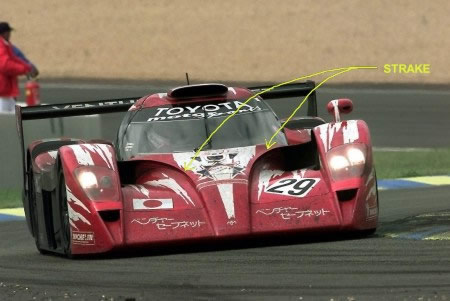
A number of years ago I wrote a piece describing vortex lift and the possibility of its application on the Toyota GT-One. Since that time I've had the opportunity to speak with a number of aerodynamacist about the idea. More recently, in email conversations with Juha Kivekas, I've have come to some different conclusions regarding the principle in general and the Toyota GT-One specifically. To recap, my thought was that the Toyota GT-One was utilizing the strake detail (image left) to generate a vortex that would travel the length of the cockpit and flow under the wing enhancing the low pressure side efficiency.
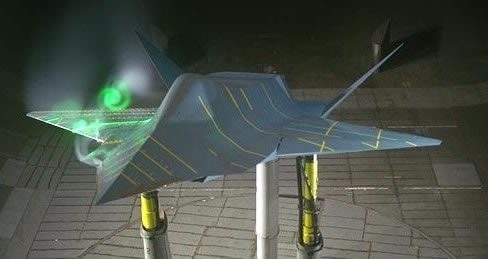
Vortex lift is seen in a number of applications in aircraft and in nature. This principle is what makes, of all things, insects able to fly. Aerodynamic theory states that as an aerodynamic surface gets smaller, it becomes less efficient at generating lift. An insect's wing generates a vortex on the top surface (the low pressure side) which greatly increases the surface's ability to produce lift. Modern supersonic combat aircraft use this idea to increase subsonic aerodynamic performance. The strakes near the cockpit of a F-16 or F/A-18 generate vortices that run over the top side of the wing creating more efficient lift by inducing higher speed and therefore lower pressure. But these vortices aren't present in normal flight, and are only generated when the aircraft achieves a high angle of attack while either maneuvering or landing. Juha Kivekas points out, "in these conditions the flow stays attached at the incredible angles because of the vortex energy mix phenomenon". Or, stated more simply, flow separation is delayed by the rotating vortices which mixes the boundary layer flow and the main stream flow imparting energy to the more stagnant boundary layer.
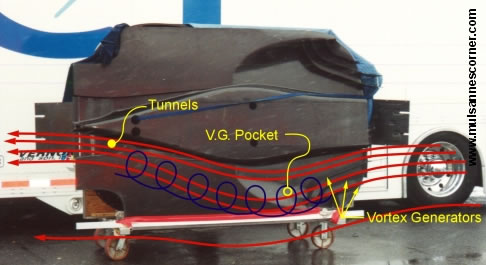
Vortex lift itself isn't unique as it is used through out motorsports, primarily to enhance bottom side downforce generation (image, Lola Champ Car underfloor). One problem is that vortices come with an inherent drag penalty that can dramatically reduce their effectiveness, especially when used in the top side flow regime. Vortices are also very fragile in their nature and therefore difficult to utilize. Which gets us back to the Toyota GT-One. The location of the strake on the GT-One is upstream of a low pressure area created by the shape of the cockpit. Any vortex generated would not have a particularly long life as it would probably be very small to start with and would easily reattach due to that suction point. Secondly, the vortex length necessary to effect the rear wing would be problematic as longitudinal vortices burst very quickly. Given the distance and the environment (various low pressure areas created by the cockpit, bodywork, etc.), it is doubtful that any vortex generated at the front of the car would survive to effect the rear.
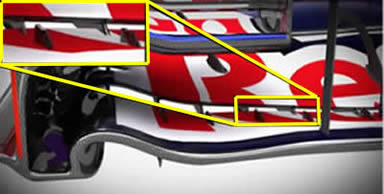 |
Vortex generators on Red Bull Racing front wing are there to help to regulate vortices and air streams aroud and behind front tires and they can isolate high from the low pressure zones. Picture is from middle of the year 2013. |
Though ultimately vortices could be used for the benefit of top side race car aerodynamics, specifically in drag reduction. Juha Kivekas sums it up best, "It certainly is possible to use longitudinal vortices to fill the wake of the cockpit bulge. This could be done using delta wings on the sides of the cockpit. And actually there have been studies on lorries where angled delta wing were used near the trailing edge of the cab and have been found to increase base pressure; that is, to reduce drag. The vortices steal energy from the main flow and mix it into the wake flow and thus reduce the effective length of the wake. This is Mother Nature's explanation, we simply call it reduced drag."
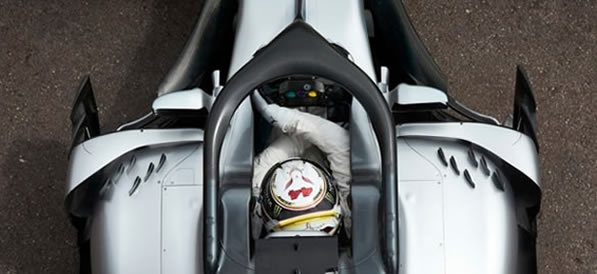
Overhead shot of the Mercedes W09 with six vortex generators on each sidepod
